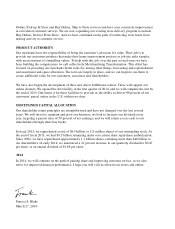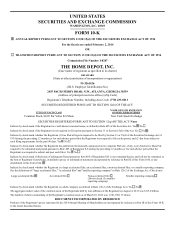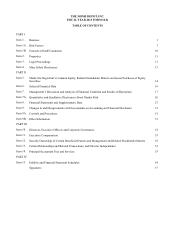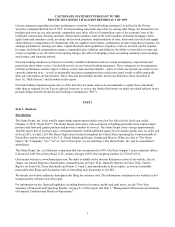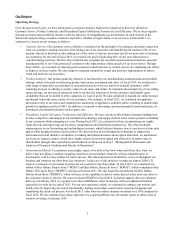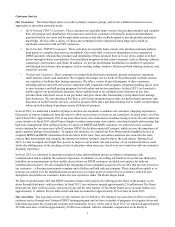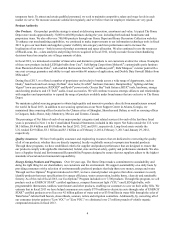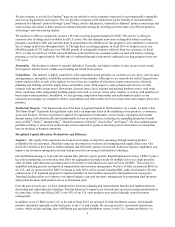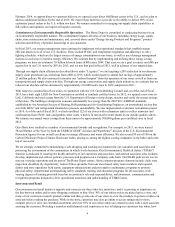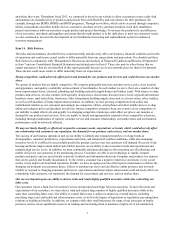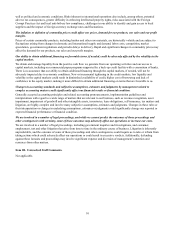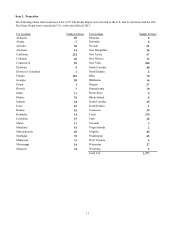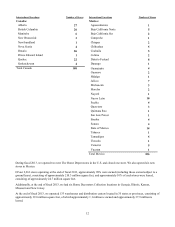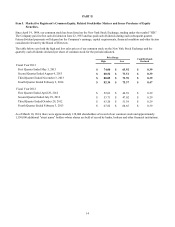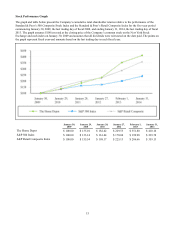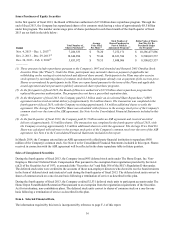Home Depot 2013 Annual Report Download - page 13
Download and view the complete annual report
Please find page 13 of the 2013 Home Depot annual report below. You can navigate through the pages in the report by either clicking on the pages listed below, or by using the keyword search tool below to find specific information within the annual report.
8
These positions have historically had high turnover rates, which can lead to increased training and retention costs. There is no
assurance that we will be able to attract or retain highly qualified associates in the future.
Uncertainty regarding economic conditions and other factors beyond our control could adversely affect demand for our
products and services, our costs of doing business and our financial performance.
Our financial performance depends significantly on the stability of the housing, residential construction and home
improvement markets, as well as general economic conditions, including changes in gross domestic product. Adverse
conditions in or uncertainty about these markets or the economy could adversely impact consumer confidence, causing our
customers to delay purchasing or determine not to purchase home improvement products and services. Other factors beyond
our control – including high levels of unemployment and foreclosures, interest rate fluctuations, fuel and other energy costs,
labor and healthcare costs, the availability of financing, the state of the credit markets, including mortgages, home equity
loans and consumer credit, weather, natural disasters and other conditions beyond our control – could further adversely affect
demand for our products and services, our costs of doing business and our financial performance.
If we do not maintain the privacy and security of customer, associate, supplier or Company information, we could damage
our reputation, incur substantial additional costs and become subject to litigation.
Our business involves the storage and transmission of customers' personal information, consumer preferences and credit card
information, as well as confidential information about our associates, our suppliers and our Company. Our information
systems are vulnerable to an increasing threat of continually evolving cybersecurity risks. Any significant compromise or
breach of our data security, whether external or internal, or misuse of associate or customer data, could significantly damage
our reputation, cause the disclosure of confidential customer, associate, supplier or Company information, and result in
significant costs, lost sales, fines and lawsuits. While we have implemented systems and processes to protect against
unauthorized access to or use of secured data and to prevent data loss, there is no guarantee that these procedures are
adequate to safeguard against all data security breaches or misuse of the data. The regulatory environment related to
information security, data collection and use, and privacy is increasingly rigorous, with new and constantly changing
requirements applicable to our business, and compliance with those requirements could result in additional costs.
A failure of a key information technology system or process could adversely affect our business.
We rely extensively on information technology systems, some of which are managed by third-party service providers, to
analyze, process and manage transactions and data. We also rely heavily on the integrity of this data in managing our
business. In order for these systems and processes to operate effectively, we or our service providers must periodically
maintain and update them. We or our service providers could experience errors, interruptions, delays or cessations of service
in key portions of our information technology infrastructure, which could significantly disrupt our operations and be costly,
time consuming and resource-intensive to remedy.
Disruptions in our customer-facing technology systems could impair our interconnected retail strategy and give rise to
negative customer experiences.
Through our information technology developments, we are able to provide an improved overall shopping environment and a
multichannel experience that empowers our customers to shop and interact with us from computers, tablets, smart phones and
other mobile devices. We use our website both as a sales channel for our products and also as a method of providing product,
project and other relevant information to our customers to drive both in-store and online sales. We have multiple online
communities and knowledge centers that allow us to inform, assist and interact with our customers. Multichannel retailing is
continually evolving and expanding, and we must effectively respond to changing customer expectations and new
developments. Disruptions, failures or other performance issues with these customer-facing technology systems could impair
the benefits that they provide to our online and in-store business and negatively affect our relationship with our customers.
We rely on third-party suppliers. If we fail to identify and develop relationships with a sufficient number of qualified
suppliers, or if our current suppliers experience financial difficulties, our ability to timely and efficiently access products
that meet our high standards for quality could be adversely affected.
We buy our products from suppliers located throughout the world. Our ability to continue to identify and develop
relationships with qualified suppliers who can satisfy our high standards for quality and our need to access products in a
timely and efficient manner is a significant challenge. Our ability to access products also can be adversely affected by
political instability, the financial instability of suppliers (particularly in light of continuing economic difficulties in various
regions of the world), suppliers’ noncompliance with applicable laws, trade restrictions, tariffs, currency exchange rates,
supply disruptions, weather conditions, natural disasters, shipping interruptions or costs, and other factors beyond our control.


